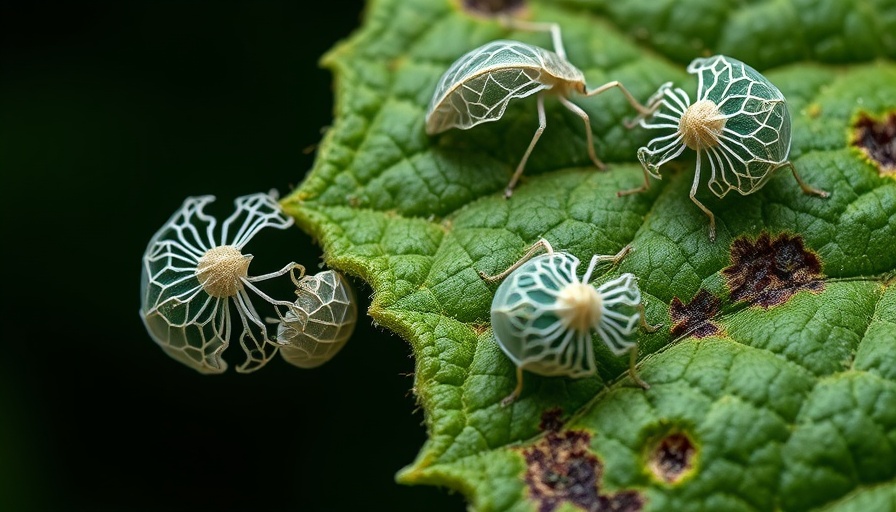
Understanding Lace Bugs: Not Just Pretty Pests
Lace bugs might sound harmless due to their delicate appearance, but these intricate insects can do a number on your beloved plants. Belonging to the Tingidae family and prevalent in North America with over 140 species, lace bugs target the underside of leaves on both deciduous and evergreen plants. As they feed, they leave behind unsightly white or yellow spots on the upper surfaces of leaves, often mistaken for damage from other pests like thrips or spider mites.
Identification: Spotting Lace Bugs in Your Garden
Most commonly, you're likely to encounter species such as the azalea lace bug or those from the genus Corythucha. Identification may seem tricky since they share similarities across species. However, lace bugs are often host-specific. If you find lace bugs on your azaleas or another listed plant, it’s usually straightforward to determine their identity. Notably, nymphs are dark, flat, oval-shaped, and wingless, making them distinct in their habitat.
Preventative Measures: Keeping Lace Bugs at Bay
The damage inflicted by lace bugs, while mainly cosmetic, can be disappointing for garden enthusiasts. Implementing a proactive management strategy, particularly organic methods, can be advantageous. Regular monitoring and early identification go a long way in controlling these pests. Use a change in your gardening routine, like incorporating pest-resistant plants, as a form of prevention. Regularly check the undersides of leaves where lace bugs prefer to feed.
Effective Control Methods: From Organic to Chemical Solutions
When it comes to controlling lace bugs, several methods are effective. Organic control methods, such as introducing natural predators or using neem oil, can minimize their presence significantly. Alternatively, if the infestation escalates, various chemical pesticides are available. Always follow guidelines for any pesticide application to ensure the safety of beneficial insects and pollinators.
Why Knowing About Lace Bugs Matters: A Gardener's Perspective
Being informed about lace bugs is essential not only for maintaining a visually appealing garden but also for supporting overall plant health. While their damage may not always affect the health of mature plants, understanding their presence equips gardeners with the knowledge necessary to protect their plant investments
Emotional Impact: The Love for Your Garden
The connection gardeners have with their plants goes beyond aesthetics. A flourishing garden becomes a canvas that showcases personal effort and creativity. Learning how to successfully manage lace bugs can enhance this bond, turning potential disappointment into a learning experience that empowers you to care for your green space even better.
Practical Gardening Insights: Tips to Enhance Plant Health
Integrating various gardening practices, including proper watering techniques, mulch application, and regular pruning, can significantly improve your plants' resistance against pests like lace bugs. Furthermore, implementing companion planting can create a more diverse ecosystem in your garden, making it less susceptible to insect attacks. New technologies in gardening tools like pest monitors are also available to help track and manage pest populations effectively.
Take Action: Make Your Garden Flourish
Gardening is more than simply planting seeds; it's about cultivating knowledge and resilience. Equip yourself with these insights on managing lace bug infestations while continuing to explore your passion for nurturing plants. Don’t hesitate to learn more about organic gardening techniques and effective control measures to protect your plants and create a garden that thrives.
 Add Row
Add Row  Add
Add 




Write A Comment